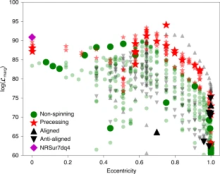
Abstract
The origin of black hole mergers discovered by the LIGO1 and Virgo2 gravitational-wave observatories is currently unknown. GW1905213,4 is the heaviest black hole merger detected so far. Its observed high mass and possible spin-induced orbital precession could arise from the binary having formed following a close encounter. An observational signature of close encounters is eccentric binary orbit5,6,7; however, this feature is currently difficult to identify due to the lack of suitable gravitational waveforms. No eccentric merger has been previously found8. Here we report 611 numerical relativity simulations covering the full eccentricity range and an estimation approach to probe the eccentricity of mergers. Our set of simulations corresponds to ~105 waveforms, comparable to the number used in gravitational-wave searches, albeit with coarser mass ratio and spin resolution. We applied our approach to GW190521 and found that it is most consistent with a highly eccentric (e=0.69+0.17−0.22e=0.69−0.22+0.17; 90% credible level) merger within our set of waveforms. This interpretation is supported over a non-eccentric merger with >10 odds ratio if ≳10% of GW190521-like mergers are highly eccentric. Detectable orbital eccentricity would be evidence against an isolated binary origin, which is otherwise difficult to rule out on the basis of observed mass and spin9,10.